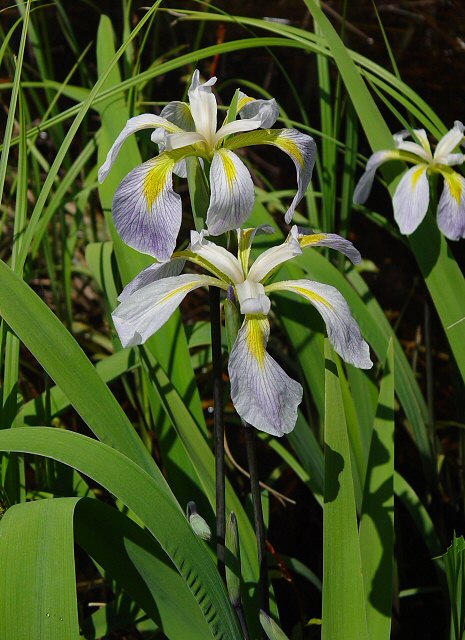Iris virginica L.
Southern Blue Flag

Native
CC = 6
CW = -5
MOC = 44
© DETenaglia
Iris virginica L.Southern Blue Flag | |
 |
Native CC = 6 CW = -5 MOC = 44 |
© DETenaglia |
|
Family - Iridaceae Habit - Rhizomatous perennial forb, the rhizomes lacking conspicuously thickened areas. Stems - Erect to arching, to 1 m, about as long as to slightly shorter than the leaves, often arching at fruiting.
Leaves - Basal and on the aerial stems, 35-100 cm long, 10-30 mm wide, erect to more commonly arching near the tips.
Inflorescence - Clusters of flowers terminal and axillary, each with 1-4 flowers, the spathelike bracts unequal, 4-14 cm long, mostly herbaceous, green, sometimes partially membranous.
Flowers - Sepals 7-10 cm long, spreading outward to arching downward, obovate, with a finely hairy central band, light violet to light violet-blue with a broad yellow area in the basal half. Petals somewhat shorter and narrower than the sepals, spreading, light violet to light violet-blue.
Fruits - Capsules 7-11 cm long, oblong-elliptic in outline, 3-angled, with a single rib at each angle.
Flowering - May - July. Habitat - Wetlands, including fens, marshes, sloughs, bottomland prairies, ponds margins, and ditch banks; sometimes in shallow water. Origin - Native to the U.S. Lookalikes - I. cristata, I. brevistylis. Other info. - This species can be found throughout Missouri but is most common in the northern and southeastern portions of the state. It also occurs in much of the eastern U.S., most commonly in the upper Midwest. Missouri's plants belong to variety shreveri (Small) E.S. Anderson, having fruiting capsules which can reach 11 cm in length. Variety virginica has shorter capsules (up to about 7 cm in length) and shorter stems, and is found mostly in the southeastern Coastal Plain. Photographs taken some where in southern MO., 7-22-02, and in Montgomery County, AL., 4-9-05 (DETenaglia); also at Shaw Nature Reserve, Franklin County, MO, 5-18-2009 and 5-17-2022 (SRTurner). Split fruit photo 9-24-2020 (KBildner). |